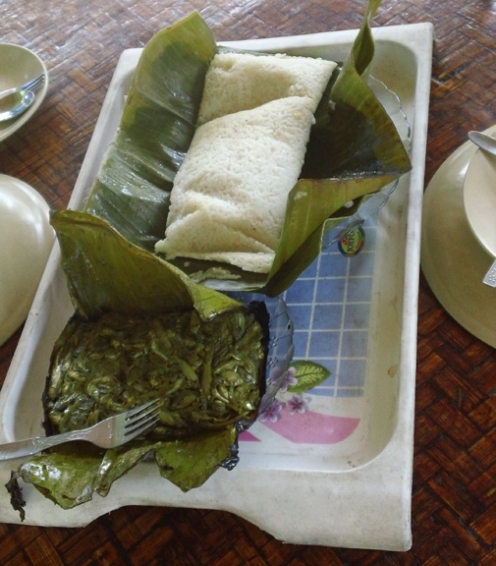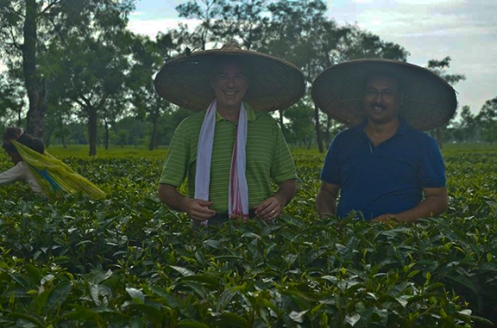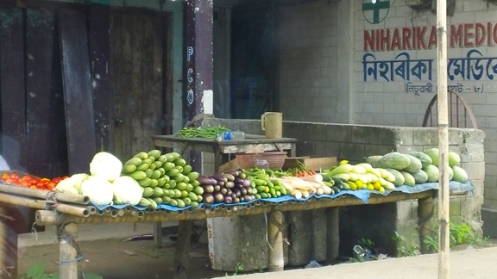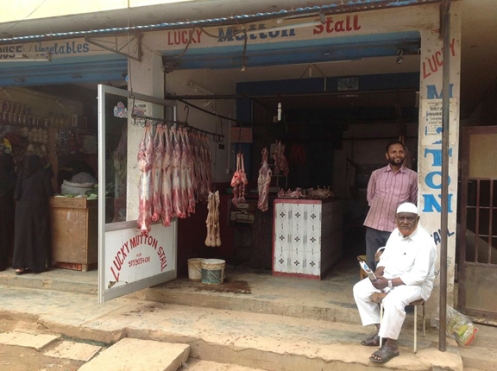On Indian food
I am asked a lot of questions during my stay in India: from Indian students, “What are schools like in America?” “What are U. S. students like?” “Do you have family?” and “Do you like WWE?”; from American family and friends, “What’s the weather like?” “How are the bathrooms?” and “Are you OK?” But the question I’m asked most often—from both sides of the Atlantic and Indian Oceans is “What do you think of Indian food?”
Indian food in America is an exotic indulgence. Except probably for the most rural areas in the States, it’s easy to find an Indian restaurant, many of them are quite good, and telling people you ate at one last month gives you a sort of cultural capital, an appearance of post-national, post-racial cool.
Indian food in India is eaten three times a day, seven days a week. In Bangalore, there are Chinese restaurants, Thai restaurants, as well as McDonalds and TGI Fridays to give locals a break from the norm and the postmodernist cachet, and I assume a similar selection is available in other big cities. Out here in Assam, there is no McDonalds or other cachet-giving brand, and what is labeled a “restaurant” is really just a dhaba, a food stall, with some plastic chairs.
My first week in India I thought I would be losing some weight. At the end of my second week in India and my first week in Jorhat, I think I’ve put on a few pounds. At the Royal Orchid Hotel in Bangalore, the trays of food had little cards so I could I name what I liked. Otherwise, I’ve been asking the names of foods and how they are prepared. My notes are incomplete, but here is an epic catalog of the dishes I have enjoyed:
- Idli. Steamed rice cakes; the breakfast food of southern India. Often dipped in sambar, a savory, juicy tomato stew, although it is also eaten with a variety of chutneys. Even on mornings when my stomach wasn’t feeling particularly pro-Bharat, I would have idli with some fruit jam or flavored honey, and it was delicious.
- Dosa. Another south Indian breakfast dish, heartier than idli. A batter made from rice flour is cooked like a huge pancake, rolled around a potato stuffing, and served with a red and/or white chutney. The hotel in Bangalore had an omelet station, and I was advised to ask for one there. The omelet cook couldn’t fulfill my request, so a server said he’d do it and disappeared in the back. When he came out with the dosa on a plate, it smelled and looked so good that half the TGC fellows ordered it. It tasted as good as it looked.
- Paneer. Indian cheese, with the consistency of ricotta salata but the taste of a creamy cottage cheese. Here in Assam I have seen it several times with a brown sauce, called shahi paneer. It is also quite delicious with a cooked green leafy vegetable (like spinach) as in palak paneer. A host family served us another version, creating a baked mixed vegetable dish figuring it would provide a European option in case the other plates were too exotic. Topped with sliced tomatoes and paneer, it was an excellent—and to me still Indian—dish.
- Dal. Lentils. Smaller than brown lentils, dal is usually made in a savory soup a little thinner than Italian lentil soup. I had masoor dal in Assam and dal makhani in Bangalore. The masoor dal here at the Guest House has a nice little bit of heat. The difference between the two is a different kind of lentil. In Assam, this is almost always eaten with rice; in fact, almost everything here is eaten with rice.
- Chicken masala. In the States, I remember masala being mainly a red sauce, but here it is brown and has more curry flavor. The cook at the Guest House saw it was on my list of favorite foods (thanks to everything made by our host Assamese families being on the list), so he made it for us today for lunch, and it was still quite good. I should note that chicken in India is not served in large identifiable pieces as it is in the States. Rathindra has gushed more than once about his experience in America shopping at the supermarket and seeing wrapped packages of separated chicken parts (“Breast! Leg! Whatever you want! And only those pieces!”). Here the chopping seems to be more random into large-bite-sized pieces, from which you suck the meat and spit out the bones.
- Rohu fish. Fish curry. Fish is a very popular protein in Assam, thanks to the various rivers and ponds in this region. Several fresh fish stands line the roads just outside the main drag. I don’t know if natives are using the Assamese word or having a hard time with the English word, but often I’ve heard it called something between “peace” and the first syllable of Pesci (a great Italian-American from the Bronx as well as, coincidently or not, the Italian word for fish). I’ve had it fried but my favorite has been stewed with vegetables in a thin curry-boosted juice, served by a host Assamese family.
- Kuchi maach. Fried small fish, like anchovies but not as salty and shaped more like minnows, eaten whole. Another delicacy you can get only from loving Assamese families.
- Upma. I saw this food only once, at breakfast in Bangalore, and have been looking for it ever since. It tastes like a mix of grits and vegetables, and is another south Indian breakfast treat. I don’t know why so many good breakfast items come from southern India.
- Bhindi poriyai. Okra, called “ladyfingers” here in India, fried with other vegetables and spices.
- Malai kofta. Balls made from paneer and vegetables (kofta) are cooked in a light, creamy gravy (malai).
- Bamboo shoot. Boiled and mixed with spices. We were headed to lunch at the home of an extended Assamese family, and our host, Rathindra, is seeing bamboo shoots in nearly every roadside stand and licking his chops. So I’m getting a hankering for bamboo shoots too, and I don’t even know what they taste like. We sit down for lunch and guess what one of the vegetables is? That’s right, bamboo shoots—glistening, brown, with just enough spice and crunch. It gets even better after lunch when the family takes us out and shows us the bamboo tree, with its little shoots sprouting up from the bottom. Everything we ate except for the fish, chicken, and rice, came fresh from the family’s garden.
- Kochoo pata. If I remember right, a sort of creamed spinach, except it’s not spinach, it’s another green leafy vegetable (which the Assamese family showed us in their garden) cooked into a creamy consistency with a good amount of garlic. I asked for seconds.
- Papdi chaat. A kind of salad made from fried bread (papdi). The hotel in Bangalore served a variety of chaat, and this, along with aloo chaat (potato salad) was probably my favorite.
- Nimbu paani. Sparkling water mixed with lemon and sugar, then decorated with mint. I was served this refreshing drink by an Assamese family after its head of household had given us a tour of the tea factory he manages. What a treat—both the drink and our new friends I will remember every time I drink it.
- Chira bhaja. A snack we had with the nimbu paani. Rice is boiled and then lightly crushed (sounds like an oxymoron, but remember, it’s India, and anything is possible). Then the crushed grains are fried with some spices, perhaps some nuts and dried lentils. The grains may also be baked in sand and put through a sieve to separate the edible from the inedible. Apparently, this snack is sold in plastic bags by shops.
- Prasaad. Similar to chira bhaja except it’s made with lentils instead of rice. I prefer chira bhaja, but the story I have for prasaad is better. One evening we are driven to what looks like a temple (I should note here that we often don’t know where we are going until we get there, and we don’t understand the place’s significance until it’s explained to us at the place or after much questioning in the car). We take off our shoes and socks and enter. Deepali, an Assamese woman who is our host’s former principal and our guide for the cultural visits out of school, explains to us that this not a temple but a naamghar, a place where the name of a god is spoken and he/she is prayed to. We approach the thingee at the front, and a man clad only in a loincloth comes out from behind the curtain. Deepali and he speak in Assamese for several minutes. The man pulls out a plastic bag and indicates that we all are to hold our hands out. He puts some mixed grainy stuff into our hands as well as a small banana about the length of my palm. He gives the bag to Deepali. We walk off in our direction, and he in his behind the curtain. Laura and I look at each other like, “What the heck is going on?” and continue to hold out our hands, now full of … something. Deepali and Rathindra begin eating the grains. Maybe it’s because I feel I’m riding a wave of gastronomic good luck or maybe it’s the probiotics I’m taking every day, but I decide to try this stuff, and it’s not bad, so I finish it off. Later I find out the food is called prasaad and how it’s made, and even later I gather up enough courage to ask, “Why did that man give us food?” Rathindra tells me the priests in the naamghar give food as a gift from the gods, similar to the bread and wine in a Christian church. This is not an isolated incident: we visit a bigger naamghar in a town about 30 kilometers away and the priests are so excited to see us that a young one runs back in as we’re leaving and chases us down on the steps with a plastic bag filled with bananas, slice apple, and coconut.
- Gajjar halwa. I had this once in Bangalore with mango ice cream, and one of the students at KVAFS Jorhat listed eating this dessert as his hobby, to much uproar from his classmates. Shredded carrot is boiled, then mixed with some flour, sugar, and spices like cinnamon to form a kind of paste, which is then fried in ghee (clarified butter). I could see how eating it would be a very enjoyable hobby.
- Rasgula. A Bengali contribution to the national dessert menu. Milk curd is mixed with some flour and sugar to form a ball, which is then boiled in syrup. The ball puff out and are very light, and the syrup seeps around your mouth with each bite. A nice variation is ras malai, which boils the milk curd balls in a thin custard. You can then serve the ras malai with that custard or, as it was in an Assamese house, misti doi or sweet yogurt. As an added touch, the hotel in Bangalore served the ras malai with jalebi, a crunchy carmelized something rolled into a coil.
- Fruit salad with custard. I never found out the same for this concoction, but I had it several times from the Guest House and from our new Assamese friends. It reminds me of going through Italy and discovering the delicious simplicity of a macedonia, fresh cut fruit marinated in a little bit of sweet wine and sugar. Put a bowl of either the Italian or the Indian version in front of me after dinner, and you couldn’t do me any better.
I have stayed away from chilies (although they have been offered) and anything hot, so I suppose I’ve avoided the full range of authentic experience, but I’ve also avoided (so far, knock wood) sweating clammily and while squatting repeatedly over the hole in the floor that serves as a toilet in paperless public and private places, so I think I’m making a good bargain.
So to answer that often asked question, I like Indian food, probably more so than ever. There are many things I’m looking forward to upon returning to the States: reliable water pressure, the lefty-loosey-righty-tighty standard, the impulse to get things done, prevalent wi-fi, highways, the hot-water-is-the-knob-on-the-left standard (although the little spray nozzle next to toilets in hotels is a nice touch), central air conditioning, and not worrying about having to run water through a portable filter when I brush my teeth. But I wonder if I will like the food.
Fish and rice cooked in banana leaves. We had this at the Nature Hunt Eco-Camp, just outside of Kaziranga National Forest in Assam.
Assamese lemons, given to us by one of the families that hosted us for lunch one afternoon.
What is food in Assam without tea? Here I am with one of the managers of the Meleng Tea Estate, pretending to pick tea leaves.
Fresh vegetable stand in Jorhat, Assam.
Meat stand in a predominantly Muslim area of Bangalore.
If you’re feeling homesick in India, many cities offer American chain restaurants. We saw McDonalds, KFC, Dominos, Subway, TGI Fridays. You’ll see some different offerings from the menus you’re used to, however. At one of the schools we visited in Bangalore, the staff went out and bought us a snack from a nearby McDonalds, perhaps hoping we’d feel at home. But McDonalds in India does not serve beef (you can get beef at other U. S. chains if you really want it). So our snack was the McAloo Tiki Burger, which you can see by the photo that I found quite tasty before thinking of commemorating the event visually. “Aloo” means potato, and “Tikki” means patty, so that’s what it is: a potato patty with a slice of tomato and a light curry sauce on a bun.






Thanks for the vivid gastronomic catalog. I too would stay away from the spicier foods if the outcome were as you have described. Paperless toilets? Uh . . . no.
Andrew, I too thought I would lose weight….I am sure I have not. I am stuffed every moment because our hosts insist that we eat until we are overstuffed.
Though it has been wonderful, I personally am looking forward to a salad!
Lunch and dinner in Assam seem to be always served with a little side salad of tomatoes, cucumbers, carrots, and sweet red onion. There is no dressing, just some lemon wedges. Usually the veggies are sliced, but for some reason at the Guest House they have been chopping and mixing them lately.
My dear Dr. Shipe: It is a true pleasure to read your blog! The information is wonderful and you are an excellent writer! Of course, my particular favorite entry so far has been this one…about food. What a great source of pride and identity cooking is to Indian women! In the 14 days I spent in Gujarat…I think had been invited to 17 dinner parties! The ladies talked quite frequently about their signature dishes…which meant little more than adjusting the amount of a particular spice or two…but it make all the difference! I was particularly fond of coconut favored dishes which, I was told, means that the person was raised in the South where the trees could be found! Love to you! See you soon!